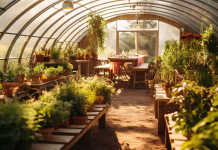In this guide, we will explore the key aspects of selecting the perfect location, choosing the right herbs, designing a tranquil layout, and providing essential care for your garden sanctuary.
Additionally, we will discuss how to enhance the atmosphere with decorative elements to create a truly relaxing and serene environment.
Selecting the Perfect Location for Your Herb Garden Sanctuary
When selecting the perfect location for your herb garden sanctuary, it is important to consider factors such as sunlight, soil quality, and accessibility.
The importance of sunlight in herb garden growth cannot be overstated. Most herbs require at least 6 hours of direct sunlight each day to thrive.
Herbs generally prefer well-draining soil that is rich in organic matter.
Select a location that is easily accessible for watering, harvesting, and tending to the herbs.
Choosing the Right Herbs for Your Garden
Some recommended herbs for small spaces include basil, thyme, chives, and mint. Additionally, consider selecting herbs that have medicinal properties. For example, lavender is known for its calming properties and can be used to relieve stress and promote sleep. Echinacea is another popular herb that can boost the immune system and help alleviate cold symptoms.
Designing a Tranquil and Functional Herb Garden Layout
Here are some key tips to keep in mind:
- Utilize vertical space by incorporating hanging baskets or trellises.
- Opt for compact herb varieties or utilize container gardening.
- Implement tiered raised beds or shelves to maximize planting area.
Incorporating water features in your herb garden design:
- Install a small fountain or pond to add a soothing ambiance.
- Integrate a drip irrigation system to ensure proper hydration.
- Consider incorporating a rain barrel for sustainable water usage.
Essential Tips for Caring for Your Herb Garden Sanctuary
One of the key challenges in herb gardening is dealing with herb garden pests. To combat this issue, it is advisable to regularly inspect the plants for any signs of damage or infestation and take necessary steps to eliminate the pests. Additionally, using organic herb garden fertilizers is crucial for providing the necessary nutrients to the plants without the use of harmful chemicals. These fertilizers not only promote healthy growth but also maintain the integrity of the soil. By following these tips, you can create a thriving and sustainable herb garden sanctuary.
Creating a Relaxing Atmosphere With Decorative Elements for Your Herb Garden
Here are five decorative elements you can incorporate into your herb garden to create a relaxing atmosphere:
- Wind chimes: Hang wind chimes in your herb garden to create a gentle and calming sound as the breeze passes through them.
- Water features: The sound of flowing water from a small fountain or waterfall can create a serene environment in your herb garden.
- Garden sculptures: Place decorative sculptures strategically throughout your herb garden to add visual interest and create a sense of harmony.
- Outdoor seating: Arrange comfortable seating areas where you can relax and enjoy the beauty of your herb garden.
- Mood lighting: Use soft and warm lighting to create a cozy and inviting atmosphere in your herb garden, perfect for evening relaxation.
Key Takeaways
- Select a location with at least 6 hours of direct sunlight each day and well-draining soil rich in organic matter.
- Choose compact and well-suited herb varieties if it is for small spaces, such as basil, thyme, chives, and mint.
- Consider herbs with medicinal properties like lavender for stress relief and echinacea for immune system support.
- Maximize space by utilizing vertical gardening techniques, incorporating water features for a soothing ambiance, and using sustainable watering methods like drip irrigation.
Conclusion
In conclusion, creating a herb garden sanctuary can provide a tranquil and relaxing atmosphere while also allowing for the cultivation of various herbs.
By carefully selecting the location, choosing the right herbs, designing a functional layout, and providing proper care, one can create a beautiful and soothing sanctuary.
Incorporating decorative elements can further enhance the atmosphere and create a truly serene environment.
Please see our supporting article:
Herbs in the Polytunnel Vs. Outdoor Growing



